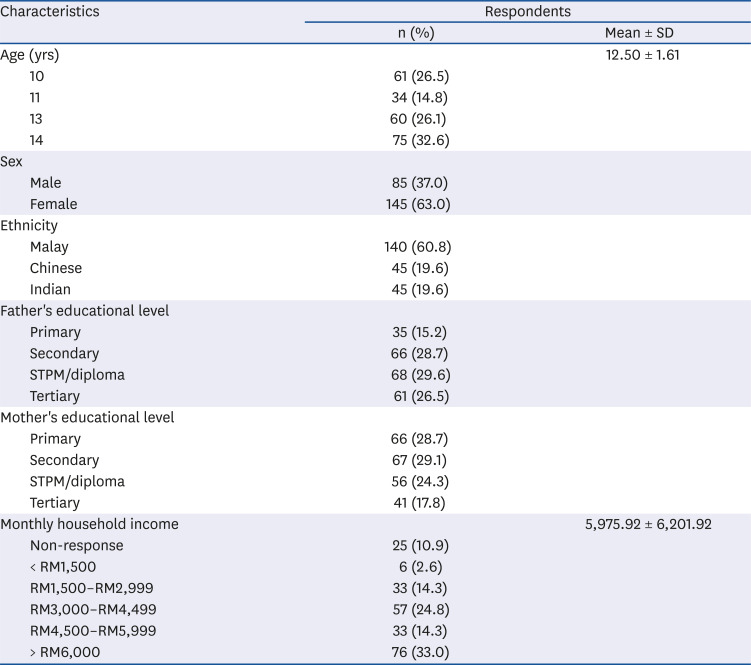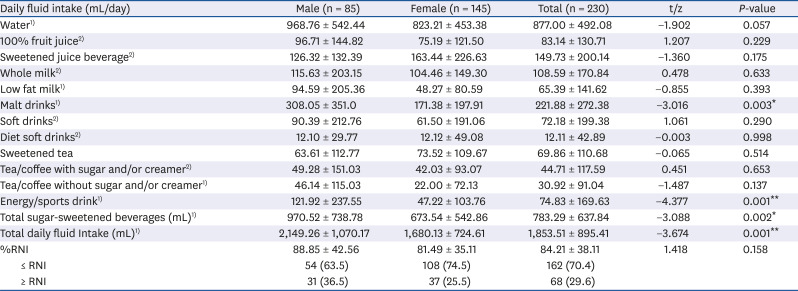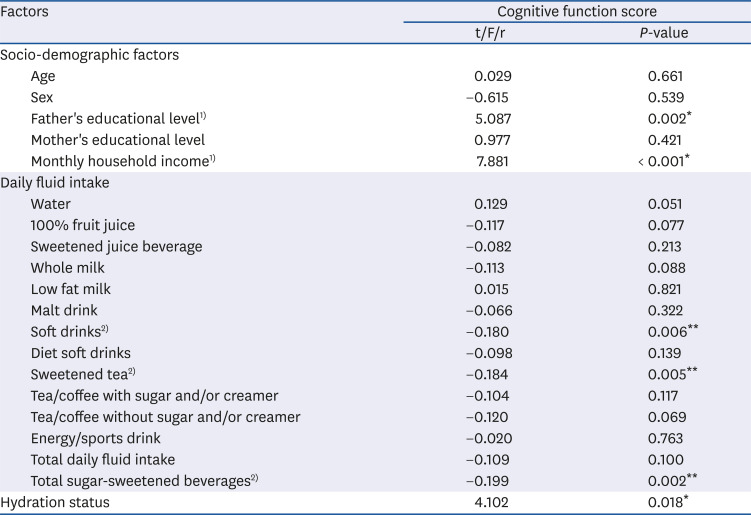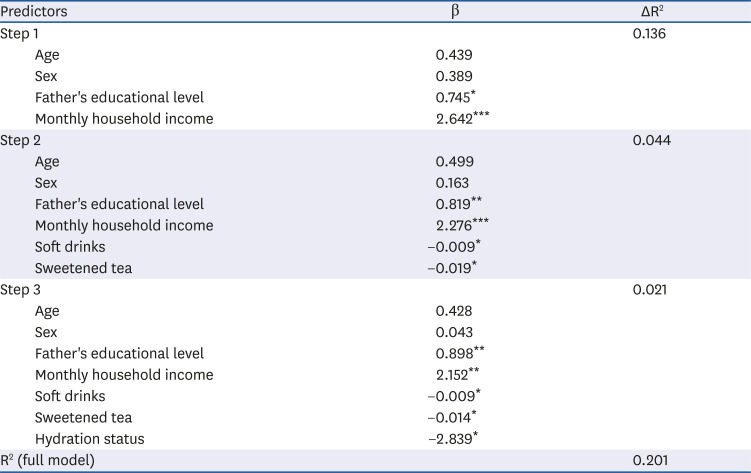1. D'Anci KE, Constant F, Rosenberg IH. Hydration and cognitive function in children. Nutr Rev. 2006; 64:457–464. PMID:
17063927.
2. Muckelbauer R, Barbosa CL, Mittag T, Burkhardt K, Mikelaishvili N, Müller-Nordhorn J. Association between water consumption and body weight outcomes in children and adolescents: a systematic review. Obesity (Silver Spring). 2014; 22:2462–2475. PMID:
25401930.
3. Iglesia I, Guelinckx I, De Miguel-Etayo PM, González-Gil EM, Salas-Salvadó J, Kavouras SA, Gandy J, Martínez H, Bardosono S, Abdollahi M, Nasseri E, Jarosz A, Ma G, Carmuega E, Thiébaut I, Moreno LA. Total fluid intake of children and adolescents: cross-sectional surveys in 13 countries worldwide. Eur J Nutr. 2015; 54(Suppl 2):57–67. PMID:
26081646.

4. Kenney EL, Long MW, Cradock AL, Gortmaker SL. Prevalence of inadequate hydration among US children and disparities by gender and race/ethnicity: National Health and Nutrition Examination Survey, 2009–2012. Am J Public Health. 2015; 105:e113–8. PMID:
26066941.

5. Masento NA, Golightly M, Field DT, Butler LT, van Reekum CM. Effects of hydration status on cognitive performance and mood. Br J Nutr. 2014; 111:1841–1852. PMID:
24480458.

6. Fadda R, Rapinett G, Grathwohl D, Parisi M, Fanari R, Calò CM, Schmitt J. Effects of drinking supplementary water at school on cognitive performance in children. Appetite. 2012; 59:730–737. PMID:
22841529.

7. Fuchs T, Lührmann P, Simpson F, Dohnke B. Fluid intake and cognitive performance: should schoolchildren drink during lessons? J Sch Health. 2016; 86:407–413. PMID:
27122140.

8. Kempton MJ, Ettinger U, Foster R, Williams SC, Calvert GA, Hampshire A, Zelaya FO, O'Gorman RL, McMorris T, Owen AM, Smith MS. Dehydration affects brain structure and function in healthy adolescents. Hum Brain Mapp. 2011; 32:71–79. PMID:
20336685.

9. Loh DA, Moy FM, Zaharan NL, Jalaludin MY, Mohamed Z. Sugar-sweetened beverage intake and its associations with cardiometabolic risks among adolescents. Pediatr Obes. 2017; 12:e1–5. PMID:
26843446.

10. Ha K, Chung S, Lee HS, Kim CI, Joung H, Paik HY, Song Y. Association of dietary sugars and sugar-sweetened beverage intake with obesity in Korean children and adolescents. Nutrients. 2016; 8:31.

11. Luger M, Lafontan M, Bes-Rastrollo M, Winzer E, Yumuk V, Farpour-Lambert N. Sugar-sweetened beverages and weight gain in children and adults: a systematic review from 2013 to 2015 and a comparison with previous studies. Obes Facts. 2017; 10:674–693. PMID:
29237159.

12. Hu FB. Resolved: there is sufficient scientific evidence that decreasing sugar-sweetened beverage consumption will reduce the prevalence of obesity and obesity-related diseases. Obes Rev. 2013; 14:606–619. PMID:
23763695.

13. Reichelt AC, Killcross S, Hambly LD, Morris MJ, Westbrook RF. Impact of adolescent sucrose access on cognitive control, recognition memory, and parvalbumin immunoreactivity. Learn Mem. 2015; 22:215–224. PMID:
25776039.

14. Wolraich ML, Wilson DB, White JW. The effect of sugar on behavior or cognition in children. A meta-analysis. JAMA. 1995; 274:1617–1621. PMID:
7474248.

15. Kaur S, Tung S, Maykanathan D, Lim YY. The association of the hydration status and parental knowledge on fluid consumption with children's weight status in Malaysia. Sri Lanka J Child Health. 2017; 46:222–229.

16. Hedrick VE, Comber DL, Estabrooks PA, Savla J, Davy BM. The beverage intake questionnaire: determining initial validity and reliability. J Am Diet Assoc. 2010; 110:1227–1232. PMID:
20656099.

17. Jan Mohamed JM, Loy SL, Mohd Taib MN, Karim NA, Tan SY, Appukutty M, Razak NA, Thielecke F, Hopkins S, Ong MK, Ning C, Tee ES. Characteristics associated with the consumption of malted drinks among Malaysian primary school children: findings from the MyBreakfast study. BMC Public Health. 2015; 15:1322. PMID:
26718818.

18. National Coordinating Committee on Food and Nutrition (NCCFN), Ministry of Health Malaysia. RNI: recommended nutrient intakes for Malaysia [Internet]. Putrajaya: Ministry of Health Malaysia;2017. cited 2019 May 10. Available from:
http://nutrition.moh.gov.my.
19. Armstrong LE, Soto JA, Hacker FJ, Casa DJ, Kavouras SA, Maresh CM. Urinary indices during dehydration, exercise, and rehydration. Int J Sport Nutr. 1998; 8:345–355. PMID:
9841955.

20. Sattler JM. Resource Guide to Accompany Assessment of Children: Cognitive Foundations. 5th ed. San Diego: J.M. Sattler;2008. p. 35–36.
21. National Coordinating Committee on Food and Nutrition (NCCFN), Ministry of Health Malaysia. Recommended Nutrient Intakes for Malaysia: a Report of the Technical Working Group on Nutritional Guidelines. Putrajaya: Ministry of Health Malaysia;2005.
22. Laksmi PW, Morin C, Gandy J, Moreno LA, Kavouras SA, Martinez H, Salas-Salvadó J, Guelinckx I. Fluid intake of children, adolescents and adults in Indonesia: results of the 2016 Liq.In
7 national cross-sectional survey. Eur J Nutr. 2018; 57:89–100. PMID:
29923119.
23. Martinez H, Morin C, Gandy J, Carmuega E, Arredondo JL, Pimentel C, Moreno LA, Kavouras SA, Salas-Salvadó J, Guelinckx I. Fluid intake of Latin American adults: results of four 2016 Liq.In
7 national cross-sectional surveys. Eur J Nutr. 2018; 57:65–75. PMID:
29858627.
24. Moreno LA, Iglesia-Altaba I, Santaliestra-Pasías AM. Fluid intake of European children and adolescents. Nutr Today. 2013; 48:S25–30.

25. Gouda Z, Zarea M, El-Hennawy U, Viltard M, Lepicard E, Hawili N, Constant F. Hydration deficit in 9- to 11-year-old Egyptian children. Glob Pediatr Health. 2015; 2:2333794X15611786.

26. Guelinckx I, Iglesia I, Bottin JH, De Miguel-Etayo P, González-Gil EM, Salas-Salvadó J, Kavouras SA, Gandy J, Martinez H, Bardosono S, Abdollahi M, Nasseri E, Jarosz A, Ma G, Carmuega E, Thiébaut I, Moreno LA. Intake of water and beverages of children and adolescents in 13 countries. Eur J Nutr. 2015; 54(Suppl 2):69–79. PMID:
26072216.

27. Ames SL, Kisbu-Sakarya Y, Reynolds KD, Boyle S, Cappelli C, Cox MG, Dust M, Grenard JL, Mackinnon DP, Stacy AW. Inhibitory control effects in adolescent binge eating and consumption of sugar-sweetened beverages and snacks. Appetite. 2014; 81:180–192. PMID:
24949566.

28. Cohen JF, Rifas-Shiman SL, Young J, Oken E. Associations of prenatal and child sugar intake with child cognition. Am J Prev Med. 2018; 54:727–735. PMID:
29674185.

29. Murray AM, Barzilay JI, Lovato JF, Williamson JD, Miller ME, Marcovina S, Launer LJ. Action to Control Cardiovascular Risk in Diabetes Memory in Diabetes (ACCORD-MIND) Substudy Investigators. Biomarkers of renal function and cognitive impairment in patients with diabetes. Diabetes Care. 2011; 34:1827–1832. PMID:
21715519.

30. Messier C. Impact of impaired glucose tolerance and type 2 diabetes on cognitive aging. Neurobiol Aging. 2005; 26(Suppl 1):26–30. PMID:
16236384.

31. Wärnberg J, Gomez-Martinez S, Romeo J, Díaz LE, Marcos A. Nutrition, inflammation, and cognitive function. Ann N Y Acad Sci. 2009; 1153:164–175. PMID:
19236339.

32. Wilson MM, Morley JE. Impaired cognitive function and mental performance in mild dehydration. Eur J Clin Nutr. 2003; 57(Suppl 2):S24–S29. PMID:
14681710.

33. Maughan RJ, Shirreffs SM, Watson P. Exercise, heat, hydration and the brain. J Am Coll Nutr. 2007; 26:604S–612S. PMID:
17921473.

34. de Bruin EJ, van Run C, Staaks J, Meijer AM. Effects of sleep manipulation on cognitive functioning of adolescents: a systematic review. Sleep Med Rev. 2017; 32:45–57. PMID:
27039223.

35. Sibley BA, Etnier JL. The relationship between physical activity and cognition in children: a meta-analysis. Pediatr Exerc Sci. 2003; 15:243–256.

36. Liang J, Matheson BE, Kaye WH, Boutelle KN. Neurocognitive correlates of obesity and obesity-related behaviors in children and adolescents. Int J Obes (Lond). 2014; 38:494–506. PMID:
23913029.










 PDF
PDF Citation
Citation Print
Print



 XML Download
XML Download